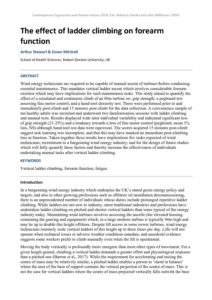| Document | Author Arthur Stewart & Dawn Mitchell |
| Abstract Wind energy technicians are required to be capable of manual ascent of turbines before conducting essential maintenance. This mandates vertical ladder ascent which involves considerable forearm exertion which may have implications for such maintenance tasks. This study aimed to quantify the effect of a simulated and continuous climb of an 80m turbine on: grip strength; a pegboard test assessing fine motor control; and a hand-tool dexterity test. These were performed prior to and immediately post-climb and 15 minutes post-climb for the data collection. A convenience sample of ten healthy adults was recruited and underwent two familiarisation sessions with ladder climbing and manual tests. Results displayed wide inter-individual variability and indicated significant loss of grip strength (21-25%) and a tendency towards a loss of fine motor control (pegboard, mean 5% loss, NS) although hand-tool test data were equivocal. The scores acquired 15 minutes post-climb suggest task learning was incomplete, and that this may have masked an immediate post-climbing loss in function. Taken together these results have implications for: tasks expected of wind technicians; recruitment to a burgeoning wind energy industry; and for the design of future studies which will fully quantify these factors and thereby increase the effectiveness of individuals undertaking manual tasks after vertical ladder climbing. |

